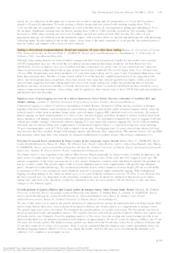Testing a silvicultural recommendation: Brazil nut responses 10 years after liana cutting.
Testing a silvicultural recommendation: Brazil nut responses 10 years after liana cutting.
Autoria: KAINER, K. A.; WADT, L. H. de O.; STAUDHAMMER, C. L.
Resumo: 1. Lianas or woody vines can be detrimental to the trees that support them. Research on liana cutting for tropical timber management has demonstrated positive yet costly benefits, but liana utting to enhance commercial outputs of nontimber forest products has not been examined. We implemented a controlled experiment to quantify the effects of cutting lianas on Brazil nut Bertholletia excelsa Bonpl. fecundity. 2. We conducted our 10-year experiment in a Brazilian extractive reserve where local harvesters collect fruits from this Amazonian canopy-emergent species as part of their forest-based livelihood system. We cut 454 lianas with a total basal area of 2 41 m 2 from 78 of 138 host trees ≥ 50 cm diameter at breast height. 3. Treated trees were significantly better producers 3 ½ years after liana cutting, and these differences increased dramatically in subsequent years, with consistent proportionally higher production in treated versus untreated individuals. 4. The number of lianas rooted within 5 m of the host tree significantly explained production levels, suggesting both above- and below-ground liana ? host tree competition. Once host crowns were liana-free, branch regrowth was highly visible, particularly in heavily infested trees, and crown reassessments suggested that liana cutting improved crown form. Additionally, liana cutting may induce some nonproducing trees to become producers and may circumvent mortality of trees heavily infested with lianas (> 75% crown covered). 5. Liana removal can be implemented easily when harvesting Brazil nut fruits. Only lianas associated with B. excelsa trees should be cut to conserve liana ecosystem functions. 6. Synthesis and applications. We quantified effects of liana cutting on Brazil nut host tree fecundity and provided estimates of increased commercial yields. Our long-term (10-year) study permits understanding of biological variation and informs related management decisions. Findings suggest that liana cutting reduces above- and below-ground competition with individual trees, ultimately allowing mature host crowns to recover such that 9 - 10 years after liana cutting, treated trees produced on average three times more fruits than untreated trees. Application of liana cutting to other tropical species would likely boost fruit and seed production, increase host tree fecundity and potentially enhance future recruitment.
Ano de publicação: 2014
Tipo de publicação: Resumo em anais e proceedings
Unidade: Embrapa Acre
Observações
1 - Por padrão são exibidas publicações dos últimos 20 anos. Para encontrar publicações mais antigas, configure o filtro ano de publicação, colocando o ano a partir do qual você deseja encontrar publicações. O filtro está na coluna da esquerda na busca acima.
2 - Para ler algumas publicações da Embrapa (apenas as que estão em formato ePub), é necessário ter, no celular ou computador, um desses softwares gratuitos. Sistemas Android: Google Play Livros; IOS: iBooks; Windows e Linux: software Calibre.
Acesse outras publicações
Acesse a Base de Dados da Pesquisa Agropecuária (BDPA) para consultar o acervo completo das bibliotecas da Embrapa.

